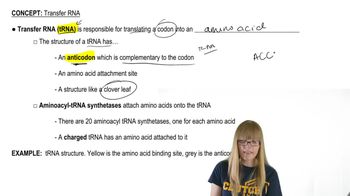On what basis have we concluded that proteins are the end products of genetic expression?
Table of contents
- 1. Introduction to Genetics51m
- 2. Mendel's Laws of Inheritance3h 37m
- 3. Extensions to Mendelian Inheritance2h 41m
- 4. Genetic Mapping and Linkage2h 28m
- 5. Genetics of Bacteria and Viruses1h 21m
- 6. Chromosomal Variation1h 48m
- 7. DNA and Chromosome Structure56m
- 8. DNA Replication1h 10m
- 9. Mitosis and Meiosis1h 34m
- 10. Transcription1h 0m
- 11. Translation58m
- 12. Gene Regulation in Prokaryotes1h 19m
- 13. Gene Regulation in Eukaryotes44m
- 14. Genetic Control of Development44m
- 15. Genomes and Genomics1h 50m
- 16. Transposable Elements47m
- 17. Mutation, Repair, and Recombination1h 6m
- 18. Molecular Genetic Tools19m
- 19. Cancer Genetics29m
- 20. Quantitative Genetics1h 26m
- 21. Population Genetics50m
- 22. Evolutionary Genetics29m
11. Translation
Translation
Problem 3
Textbook Question
The human mitochondrial genome encodes only 22 tRNAs, but at least 32 tRNAs are needed for cytoplasmic translation. How are all codons in mitochondrial transcripts accommodated by only 22 tRNAs? The Plasmodium mitochondrial genome does not encode any tRNAs; how are genes of the Plasmodium mitochondrial genome translated?
 Verified step by step guidance
Verified step by step guidance1
Understand the problem: The human mitochondrial genome encodes only 22 tRNAs, which is fewer than the 32 tRNAs required for cytoplasmic translation. Additionally, the Plasmodium mitochondrial genome does not encode any tRNAs. The question asks how translation is accomplished in these cases.
Step 1: Recognize the concept of 'wobble base pairing.' In mitochondria, the genetic code is slightly different from the standard code, and fewer tRNAs are required because of relaxed base-pairing rules at the third position of the codon. This allows one tRNA to recognize multiple codons.
Step 2: Explain how human mitochondria accommodate translation with only 22 tRNAs. The wobble hypothesis enables a single tRNA to pair with multiple codons that differ only at the third nucleotide position. This reduces the number of tRNAs needed for translation.
Step 3: Address the Plasmodium mitochondrial genome. Since it does not encode any tRNAs, translation of mitochondrial genes relies on importing tRNAs from the cytoplasm. These tRNAs are synthesized in the cytoplasm and transported into the mitochondria to facilitate translation.
Step 4: Summarize the key mechanisms: Human mitochondria use wobble base pairing to reduce the number of required tRNAs, while Plasmodium mitochondria import tRNAs from the cytoplasm to compensate for the lack of encoded tRNAs.
 Verified video answer for a similar problem:
Verified video answer for a similar problem:This video solution was recommended by our tutors as helpful for the problem above
Video duration:
2mPlay a video:
Was this helpful?
Key Concepts
Here are the essential concepts you must grasp in order to answer the question correctly.
Mitochondrial Genome and tRNA
The mitochondrial genome is a small, circular DNA molecule found in mitochondria, encoding essential proteins and tRNAs for mitochondrial function. In humans, it encodes only 22 tRNAs, which are responsible for translating mitochondrial mRNA into proteins. This limited number of tRNAs is compensated by the ability of some tRNAs to recognize multiple codons due to wobble base pairing, allowing for efficient translation despite the apparent shortage.
Recommended video:
Codon Usage and Wobble Hypothesis
The wobble hypothesis explains how the third position of a codon can pair with multiple tRNA anticodons, allowing a single tRNA to recognize more than one codon. This flexibility is crucial in mitochondrial translation, where the limited number of tRNAs can still accommodate the full range of codons. This mechanism enables the translation of mitochondrial transcripts despite the fewer tRNAs available.
Recommended video:
Guided course

Translation:Wobble Hypothesis
Translation in Plasmodium Mitochondria
In Plasmodium, the organism responsible for malaria, the mitochondrial genome does not encode any tRNAs. Instead, translation of mitochondrial genes is facilitated by importing tRNAs from the cytoplasm. This adaptation allows Plasmodium to effectively translate its mitochondrial proteins without relying on its own tRNA synthesis, showcasing a unique evolutionary strategy.
Recommended video:
Guided course

Translation initiation

 7:58m
7:58mWatch next
Master Translation initiation with a bite sized video explanation from Kylia
Start learningRelated Videos
Related Practice
Textbook Question
651
views

